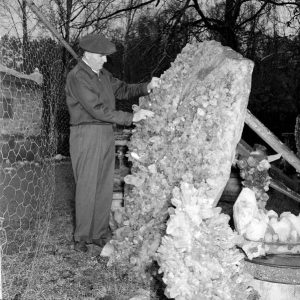calsfoundation@cals.org
Official State Mineral
aka: Quartz Crystal
On February 22, 1967, Governor Winthrop Rockefeller signed Act 128, an omnibus measure designating quartz crystal the state mineral, diamond the state gem, and bauxite the state rock. The measure was introduced in the Senate by Robert Harvey, J. Hugh Lookadoo, and Olen Hendrix, apparently as a favor to Arkansas rocks and minerals collectors and clubs; the text of the bill asserted that passage was essential in order that collectors and hobbyists might trade official state gems, rocks, and minerals with like-minded enthusiasts in other states. The measure was enacted with an emergency clause, allowing it to become effective upon the date of signing.
Act 128 helped draw attention to the distinctive quartz crystals mined in the central Ouachita Mountains and long prized by collectors. The crystals are produced from veins in sandstone and shale; the quartz belt is about thirty to forty miles long and fifteen miles wide, extending southwest from near Little Rock (Pulaski County) to Oklahoma. They are usually milky in appearance because of pockets of impurities, but many individual crystals have colorless, almost clear terminations. On large “plates” of crystals, the individual crystals are often short, but it is not unusual for smaller crystals to be six times as long as they are thick, or more. These slender points are often used in making earrings and pendants.
In 1541, according to a pamphlet issued by the Arkansas Geological Survey, the Hernando de Soto expedition observed Native Americans chipping tools and projectile points from Ouachita quartz. During the nineteenth century, as health-seekers and other travelers became more common in the Ouachitas, the fame of the area’s striking quartz crystals grew. In 1859, David Dale Owen reported that crystals were widely sold to health-seekers taking the waters at Hot Springs (Garland County). Early crystal mining took place in the Crystal Range of Montgomery County, but, by 1900, quartz was also recovered from deposits in Garland and Saline counties. Early crystal hunters were largely free to seek the stones where they wished, whether on timber sales or federal lands; few quartz miners bothered to file claims.
This unregulated condition persisted until 1942, when quartz assumed significance as a war production material. A demand for oscillator crystals (used in communications equipment) led to a flurry of prospecting and crystal extraction. A quartz-buying operation was established in Hot Springs in 1943. War’s end—coupled with the development of techniques for creating cultured, or synthetic, crystals—effectively depressed industrial demand for crystals; the market once more was driven by tourists’ and collectors’ demands. During the 1980s, popular interest in crystals’ possible metaphysical properties led to an upswing in demand; by the mid-1990s, this market section stabilized at between fifteen to twenty percent of total sales. Mining of lascas, a non-electronic grade of quartz used as feed stock for creating synthetic or fused quartz crystals, continued in Arkansas through 1997; in that year, industrial quartz mining recovered an estimated 450 tons. After 1997, industrial quartz crystal production drew upon stockpiled domestic and imported lascas supplies, relegating demand for Arkansas crystals to jewelry and specimen markets. Today, several commercial crystal mines in Arkansas allow paying collectors to hunt for specimens; rockhounding also continues on both private and public land.
For additional information:
Dodson, David, and Sarah Dodson. Rockhounding in Arkansas. Little Rock: The Dodsons, 1974.
Howard, Darcy, and Mike Howard. Collecting Crystals: The Guide to Quartz in Arkansas. Little Rock: A&I Studio Press, 2000.
U.S. Department of the Interior, U.S. Geological Survey, U.S. Bureau of Mines. An Overview of Production of Specific U.S. Gemstones. U.S. Bureau of Mines Special Publication 14-95. Washington DC: U.S. Bureau of Mines, 1995.
U.S. Department of the Interior, U.S. Geological Survey, U.S. Bureau of Mines. USGS Mineral Commodities Summaries 2015. Washington DC: U.S. Bureau of Mines, 2015. Online at: http://minerals.usgs.gov/minerals/pubs/commodity/silica/mcs-2015-quart.pdf (accessed September 14, 2022).
Ware, David. It’s Official! The Real Stories behind Arkansas’s State Symbols. 2nd ed. Little Rock: Butler Center Books, 2017.
David Ware
Arkansas Secretary of State’s Office
 Geography and Geology
Geography and Geology John Casper Branner
John Casper Branner  Robert Harvey
Robert Harvey  Olen Hendrix
Olen Hendrix  Quartz Crystal Formation
Quartz Crystal Formation 




Comments
No comments on this entry yet.